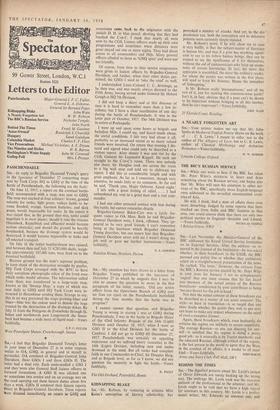Euston 3221
Letters to the Editor
Passchendaele Major-General J. F. C. Fuller, General E. A. Osborne, General Sir Bernard Paget
Kidnapping Blake John Wain
A Nearly Forgotten Art W. W. Robson The BBC's Russian Service Nicholas Temple, John North Behind The Times Frank M. Gardner 'Astor-Owned' Randolph S. Churchill Hungary Sarah Gainham Columbia Market Charles F. F. Fleet Vice Prosecutions Michael Nichol ass, A. E. Dyson The Nineties and Sixties H. R. Barton Buckingham's Water Supply John M. Cornwall Gallup Poll Mrs. I. Prosser PASSCHENDAELE
SIR,—In reply to Brigadier Desmond Young's query in the Spectator of December 27 concerning maps sent by Tank Corps HQ to GHQ at the time of the battle of Passchendaele, the following are the facts :
On June 15, 1917, a report on the eventual battle- field, accompanied with a map, was sent to GHQ. The map was marked in four colours : brown, ground suitable for tanks; light green, valleys liable to be- come flooded; orange, German batteries; and dark green, woods impassable for tanks. In the report it was stated that, as the ground then was, tanks could negotiate it in most places; should it rain the streams (Steenbeck, Reutelbeck and affluents) would become serious obstacles; and should the ground be heavily bombarded, because the drainage system would be destroyed; it would become impassable to tanks and all wheeled transport.
On July 16 the initial bombardment was opened, and between then and July 31 4,283,000 shells, weigh- ing approximately 107,000 tons, were fired on to the eventual battlefield.
Because ground was the tank's supreme problem, to keep check of the destruction wrought by gunfire, HQ Tank Corps arranged with the RFC to have daily aeroplane photographs taken of the front over which tanks would advance. The information culled from them was transferred to a large-scale map, known as the 'Swamp Map,' a copy of which was sent daily to GHQ until HQ Tank Corps were in- structed to discontinue sending them. Strange to say, this in no way prevented the maps growing bluer and bluer—blue was the colour used to denote the bogs created by the destruction of the drainage dykes. By July 31 from the Polygone de Zonnebeke through St. Julien and northwards past Langemarck the Steen- beck had become a wide moat of liquid mud.—Yours faithfully, J. F. C. FULLER West Poutzdgate Manor, Crow borough, Sussex


































 Previous page
Previous page